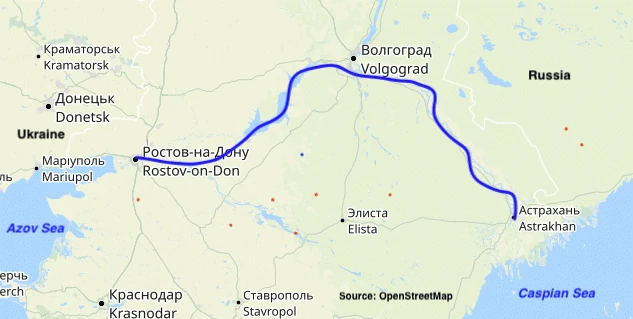Western experts are highlighting the strategic significance of the Volga-Don Canal, a critical waterway that connects the Caspian Sea with the world’s oceans, particularly the Black Sea, and links these seas with the Baltic Sea. During the Early Middle Ages, merchants and soldiers traveled between the Don and Volga rivers via a land portage spanning approximately 70 kilometers, highlighting the historical significance of this water route. Fortresses were constructed to safeguard against nomadic tribes.
The concept of connecting these two rivers is a long-standing endeavor. Ottoman Sultan Selim II initiated the initial significant effort in the mid-16th century by deploying more than 20,000 soldiers to construct a canal. However, the Ottomans famously observed that their workforce was rapidly depleting, and even the entire Turkish nation would not be sufficient to complete such a monumental task. The concept continued to captivate leaders, such as Russian Emperor Peter I, who deliberated on the possibility for centuries.
The Volga-Don Canal, which spans 101 kilometers, was finally completed on May 31, 1952, following an estimated 3.5 years of construction. The next day saw the passage of the first vessels, while a ceremonial navigation inauguration took place on July 27. The Soviet regime viewed this initiative as a chance to showcase its extraordinary capabilities and power to the world, allowing it to accomplish seemingly impossible engineering feats.
The canal is a remarkable piece of infrastructure, consisting of 13 shipping locks, three pumping stations, 13 dams, and dikes, 7 spillways and discharges, 2 emergency repair barriers, 8 bridges, and a variety of ferry crossings, halting points, and piers. Approximately 45 kilometers of the transport route traverse reservoirs. The canal, which was constructed to improve transportation and irrigate arid lands, is also navigable during the winter and transports between 7 and 12 million tons of cargo annually. In 2021, 4,400 vessels traversed the canal.
The strategic significance of the Volga-Don Canal is not limited to commercial interests. In the context of international sanctions, the Caspian Policy Center in the United States emphasizes its importance in facilitating trade and military movements between Russia and Iran. Russia has employed this internal waterway network to facilitate the transfer of warships, particularly those outfitted with missiles and artillery, between the Baltic Fleet, the Black Sea Fleet, and the Caspian Sea Flotilla.

The Baltic Fleet, Black Sea Fleet, and Caspian Sea Flotilla are three critical components of Russia’s naval strategy, each serving distinct geopolitical and military objectives in their respective regions. The Baltic Fleet, which has a complex historical significance dating back to conflicts such as the Russo-Japanese War and World War II, operates in Northern Europe, monitoring NATO activities and maintaining Russian naval influence in the Baltic region. Russia places exceptional strategic importance on the Black Sea Fleet, situated in Sevastopol, Crimea. It permits the projection of military power in regional conflicts, particularly those involving Ukraine and NATO countries, and provides Russia with essential maritime access to the Mediterranean. In the landlocked Caspian Sea, the Caspian Sea Flotilla is unique in its focused regional function, which includes the protection of Russian interests among the five bordering nations and the support of potential ground operations in this complex geopolitical region that is rich in energy resources.
In the Caspian Sea, the year 2022 represented a significant turning point in the maritime commerce between Iran and Russia. This encompasses the International North-South Transport Corridor, the Preferential Trade Agreement with the Eurasian Economic Union, and developments in bilateral trade. The river route, connecting Volgograd or Kazan to southern Iran and the vicinity of India, provides a comprehensive transportation network spanning approximately 1,800 kilometers.
However, a multitude of obstacles confront the maritime commerce between these nations. The ongoing conflict in Ukraine, extensive Western sanctions on Russia, restrictions on Russian transit in Eastern Europe, ongoing US sanctions on Iran, and the ambiguities surrounding the Joint Comprehensive Plan of Action further complicate international relations. Despite these challenges, both nations remain committed to strengthening their collaboration within the International North-South Transport Corridor framework.
Among the significant maritime trade milestones of 2022 were the arrival of the first Russian roll-on/roll-off vessel at Iran’s Nowshahr port in 21 years and agreements for joint shipbuilding initiatives. The Astrakhan regional government and Iran’s Mostazafan Foundation have signed a critical agreement to establish a shipping enterprise for the transport corridor.
Trade enhancement necessitates continued infrastructure development. The current fleet of 61 ships in the Caspian Sea of Iran is deemed insufficient to accommodate the growth of commerce volumes. Priorities include the construction of an additional 5,000-ton ships, potentially through Russian shipyards in Astrakhan, and the resolution of the roll-on/roll-off vessel deficit, which is essential for the transportation of containers and vehicles.
Ongoing logistical challenges, such as the emptying of ships after a one-way cargo delivery, lead to an increase in costs. Makhachkala port provides a year-round alternative, while ports such as Astrakhan encounter winter cold issues. Dredging projects will enhance the overall cargo capacity by accommodating vessels with a 4.5-meter draft. Infrastructure enhancements, such as the completion of the Rasht-Astara rail link, would further facilitate multimodal transportation between Iran and Russia.
The United States recognizes that it has limited direct influence in this situation and is unable to obstruct the transportation of military cargo between Russia and Iran. This maritime and transportation network offers the Russian military a strategic advantage in its confrontation with the West amidst the ongoing conflict in Ukraine.
